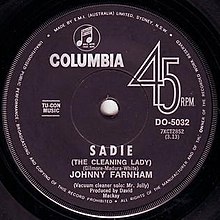Background
Farnham's manager, Darryl Sambell, had disliked "Sadie (The Cleaning Lady)" because the lyrics were so persistent. [7] However, EMI's in-house producer David Mackay insisted, so the single was released in November 1967. The song was written by United States writers Ray Gilmore, Johnny Madara and Dave White. [7] [11] Sambell approached the Australian Broadcasting Corporation (ABC) TV program This Day Tonight to do a "day in the life of" segment where they followed Farnham around to radio studios to promote the single. Sambell also arranged for the electrical appliance store Godfreys to supply a vacuum cleaner salesman, a Mr Jolly, to be on hand. [7] [12]
By arrangement with Sambell, Melbourne radio DJ Stan Rofe pretended that he disliked "Sadie" before playing it. [7] [12] Rofe continued the ploy on TV's Upright and viewers responded with calls to play the song. [12] Rofe was also a writer for Go-Set , a teen-oriented pop magazine. Another writer for the magazine, Molly Meldrum, praised Farnham's efforts. [7] "Sadie" hit No. 1 on the Go-Set National Singles Charts in January 1968 and remained there for five weeks. [2] Selling 180,000 copies in Australia, "Sadie" was the highest selling single by an Australian artist of the decade. [7] [8] The B-side, "In My Room", was written by Farnham. [10] The album, Sadie, also produced by Mackay, was released in April. [13]
According to author Jeff Jenkins, another local pop performer, Mike Furber, had the first option on recording "Sadie", but declined. Furber later told Sambell that due to this mistake he was not destined for success. [7]

John Peter Farnham AO is a British-born Australian singer. Farnham was a teen pop idol from 1967 until 1979, billed until then as Johnny Farnham. He has since forged a career as an adult contemporary singer. His career has mostly been as a solo artist, although he replaced Glenn Shorrock as lead singer of Little River Band from 1982 to 1985.
Go-Set was the first Australian pop music newspaper, published weekly from 2 February 1966 to 24 August 1974, and was founded in Melbourne by Phillip Frazer, Peter Raphael and Tony Schauble. Widely described as a pop music "bible", it became an influential publication, introduced the first national pop record charts and featured many notable contributors including fashion designer Prue Acton, journalist Lily Brett, rock writer / band manager Vince Lovegrove, music commentator Ian "Molly" Meldrum, rock writer / music historian Ed Nimmervoll and radio DJ Stan Rofe. It spawned the original Australian edition of Rolling Stone magazine in late 1972.
Colleen Hewett is an Australian singer and actress.

Whispering Jack is the twelfth studio album by Australian adult contemporary pop singer John Farnham. It was produced by Ross Fraser and released on 29 September 1986, peaking at No. 1 on the Australian Kent Music Report Album Charts. Whispering Jack became the second-best-selling album in Australia, behind only Meat Loaf's album Bat Out of Hell, and the highest-selling album in Australia by an Australian artist―24x platinum, indicating over 1.68 million copies sold; it remains the third-best-selling album of all time in Australia, as Shania Twain's Come On Over eventually eclipsed it. It spent 25 weeks at the No. 1 spot on the Album Charts during 1986–1987, it was awarded the 1987 ARIA Award for "Album of the Year", and it was the best-charting album for the decade of the 1980s in Australia. It was the first Australian-made album to be released on compact disc within Australia. One of Farnham's biggest hits, "You're the Voice", was issued as the lead single from this album and peaked at No. 1 on the Kent Music Report Singles Charts.
The Australian 1970 Radio Ban or 1970 Record Ban was a "pay for play" dispute in the local music industry that lasted from May until October. During this period, a simmering disagreement between commercial radio stations – represented by the Federation of Australian Radio Broadcasters (FARB) – and the six largest record labels – represented by Australasian Performing Right Association (APRA) – resulted in major United Kingdom and Australian pop songs being refused airplay. The government-owned Australian Broadcasting Corporation – which had its own copyright and royalty arrangement with recording and music publishing companies – did not take part in the dispute. The ban did not extend to releases by American artists. Some radio disc jockeys, such as Stan Rofe, defied the ban by playing songs according to their personal tastes.

John Farnham, billed under stage name Johnny Farnham from 1964 until 1979, is a British-born Australian pop singer who has released 21 studio albums, 6 live albums, 3 soundtracks, 19 compilation albums, 13 video albums, 3 extended plays and 74 singles.
Gregory John Macainsh is an Australian former musician and songwriter. He provided bass guitar and backing vocals for pop rockers, Skyhooks from 1973 to 1980 and subsequently for various reformations. According to Australian musicologist, Ian McFarlane, "Macainsh's biting, provocative songs were the perfect expression of adolescent obsessions and frustrations. With those songs, the band made an enormous impact on Australian social life." Macainsh became an intellectual property lawyer.

Uncovered is a solo studio album by British-born Australian singer John Farnham, produced by Little River Band's Graeham Goble, and released on 3 July 1980, which peaked at No. 20 on the Australian Kent Music Report album chart and was certified gold in 1981.

Sadie is the debut studio album by Australian pop singer John Farnham it was released by EMI Records in April 1968. The lead single, "Sadie " had been released in November 1967, it was No. 1 on the Go-Set National Singles Charts for five weeks, and was the largest selling single in Australia by an Australian artist in the 1960s. The single, "Sadie " sold approximately 180,000 copies in Australia, and was also released in New Zealand, Denmark and Germany. The second follow up album single was Jeff Barry/Ellie Greenwichs "Friday Kind of Monday" included on the album and was released in March as a double-A side with a cover of Flanagan and Allens, "Underneath the Arches" as Farnham's second single, which peaked at No. 6.
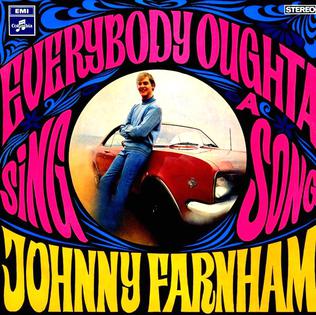
Everybody Oughta Sing A Song is the second solo studio album by Australian pop singer John Farnham and was released on EMI Records in November 1968. Its first single, released in July, was the double A-sided, "Jamie"/"I Don't Want To Love You", which peaked at No. 8 on the Go-Set National Singles Charts. The second single, "Rose Coloured Glasses" was released in October and peaked at No. 16. Writers on the album included Hans Poulsen, Neil Diamond and Quincy Jones. The album was re-released in 1974 with a different cover, it shows Farnham performing live on stage, whereas the initial 1968 release had him leaning against a Holden Monaro.
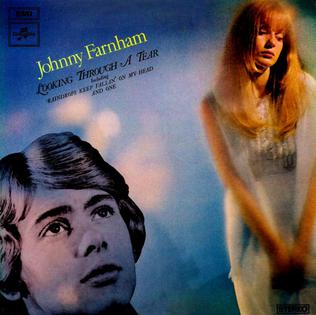
Looking Through A Tear is the third studio album by Australian pop singer Johnny Farnham, the title of which relates to a song on the album, which is a cover of an Aretha Franklin number. it was released in Australia by EMI Records in July 1970. Farnham's covers of Harry Nilsson's penned "One" which became a hit for Three Dog Night and a cover B. J. Thomas' single "Raindrops Keep Fallin' on My Head" were released as singles, and helped to propel the album to No. 11 on the Australian Kent Music Report Album Charts. "One"/"Mr. Whippy" was released as a double A-side in July 1969 and peaked at No. 4 on the Go-Set National Singles Charts. "Raindrops Keep Fallin' On My Head" was released in November and peaked at No. 1 for seven weeks in January–March 1970. Farnham wrote two songs for the album.

Christmas Is... Johnny Farnham is a studio album of Christmas songs recorded by Australian pop singer John Farnham and released on EMI Records in December 1970. The single, "Christmas Happy", was also released in December. It would be Farnham's only Christmas album until some 46 years later, when in 2016 he would release Friends for Christmas, a duet seasonal album with Olivia Newton-John.

Johnny is the fifth studio album by Australian pop singer John Farnham, which was released on HMV for EMI Records in August 1971. It peaked at No. 24 on the Australian Kent Music Report Albums Charts. Farnham had earlier No. 1 singles with "Sadie " in 1968 and his cover of "Raindrops Keep Fallin' on My Head" in 1970; a non-album single, "Acapulco Sun" was released in May 1971 but there were no charting singles from Johnny. The album features compositions from artists as diverse as George Harrison, Elton John, Stevie Wonder, Joe South and George Gershwin and Ira Gershwin.
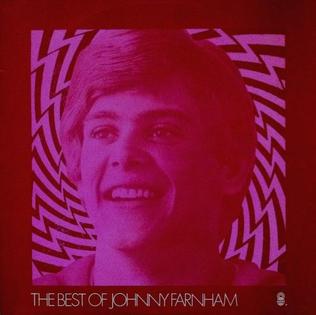
The Best Of Johnny Farnham is the first compilation album by Australian singer Johnny Farnham, it was released on World Record Club in 1971. "Sadie " was first released in November 1967 and peaked at No. 1 on the Go-Set National Singles Charts for five weeks early in 1968. His cover of the B. J. Thomas hit "Raindrops Keep Fallin' on My Head" had been released in November 1969 and peaked at No. 1 for seven weeks in January–March 1970. The album cover was available in a variety of colours including orange, red and blue.
The Masters Apprentices are an Australian rock band fronted by Jim Keays on lead vocals, which originally formed as The Mustangs in 1964 in Adelaide, South Australia, relocated to Melbourne, Victoria, in February 1967 and attempted to break into the United Kingdom market from 1970 before disbanding in 1972. Their popular Australian singles are "Undecided", "Living in a Child's Dream", "5:10 Man", "Think About Tomorrow Today", "Turn Up Your Radio" and "Because I Love You". The band launched the career of bass guitarist Glenn Wheatley, who later became a music industry entrepreneur and an artist talent manager for both Little River Band and John Farnham.

Ian Alexander "Molly" Meldrum AM is an Australian music critic, journalist, record producer and musical entrepreneur. He was the talent coordinator, on-air interviewer, and music news presenter on the former popular music program Countdown (1974–87) and is widely recognised for his trademark Stetson hat, which he has regularly worn in public since the 1980s.
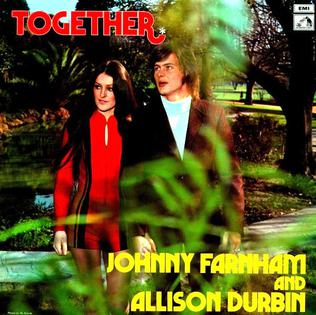
Together is a studio album of duets by Australian pop singers John Farnham and Allison Durbin, which was released on HMV for EMI Records in September 1971. It peaked at No. 20 on the Australian Go-Set's Albums Chart.
"Part Three into Paper Walls" is a song by Australian pop singer Russell Morris. It was co-written by Morris and Johnny Young and produced by Ian "Molly" Meldrum. It was released as a double A-sided single, with "The Girl That I Love", in July 1969 and peaked at number one on the Australian Go-Set chart for four weeks. Morris became the first Australian artist to achieve consecutive number-ones with their first two singles. The single was certified Gold in Australia and was the 12th highest selling single of 1969.
Ronald Stewart Tudor MBE was an Australian music producer, engineer, label owner and record industry executive. He started his career with W&G Records in 1956 as a sales representative; he became their in-house producer and A&R agent before leaving in 1966.
Darryl Lloyd Sambell was an Australian accountant, talent manager and music promoter from the mid-1960s.
